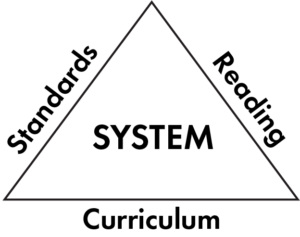Curriculum: Standards & Reading
Curriculum is the crucible which is dependent on standards and reading documents to work within a system. Standards set up expectations which become the basis for student performance in the acquisition of knowledge while reading represents both impetus and material base on which actions take place. It is important that the reading material base be carefully selected to provide a level of rigor to strengthen reading comprehension skills.

Aside from the safety and welfare of students and staff, curriculum is the foundation of a learning system. I capture it within this statement: Curriculum represents teaching, learning, and assessment within an integrated web. Also, it needs to be clearly displayed in a manner which allows it to be accessed by those who have to work within it or are interested in knowing it.
The integrated aspect of curriculum is its dynamic connectivity to all aspects of the teaching, learning process which includes instructional units and lessons, along with material support and assessments. Assessment lies within the curriculum and cannot be viewed as a separate entity residing outside of it. In reality assessment exists within every thought and action students display. It is a critical element because it figures into the learning process and allows for Vygotsky’s Zone of Proximal Development to set up a learner’s path for growth.
With the advent of Common Core State Standards (CCSS), the significance of reading bounded to new heights. All teachers are now regarded as teachers of reading, not reading teachers per se. Although the emphasis is on informational texts spread across all subjects which sets up rigorous content in history, science, art, music, and literature. But, it also supports the reading of great works of literature, as well as important non-fiction, such as the nation’s founding documents. The English language arts and literacy standards make clear what it means to read widely and with deeper understanding.
In allowing reading to take on the role it needs to, administrators and teachers must create a reading arc that displays all significant documents students are expected to read at each grade and in each subject. In doing so, we have the technology to capture this information and display it within the curriculum in a manner that gives everyone access to it who needs to know. As a 11th grade English teacher, should I be able to access key documents my current students have read and what would I do with that kind of information? Well, to start with, I would be able to instill the value of it by associating it with new knowledge and going beyond.
Curriculum captures, displays, and integrates all essential elements of teaching, learning, and assessment which has at its base, content knowledge.
References
Crain, W. (2010). Theories of development: Concepts and applications, 6th ed. Upper Saddle River, NJ: Prentice Hall.
 Dr. Bruce H. Crowder is a senior researcher for Educational Vistas, Inc. His work is primarily focused on creating pathways for deeper learning for all students through student performance and a dynamic curriculum replete with strategic teaching. Dr. Crowder may be reached at bcrowder@edvistas.com
Dr. Bruce H. Crowder is a senior researcher for Educational Vistas, Inc. His work is primarily focused on creating pathways for deeper learning for all students through student performance and a dynamic curriculum replete with strategic teaching. Dr. Crowder may be reached at bcrowder@edvistas.com


